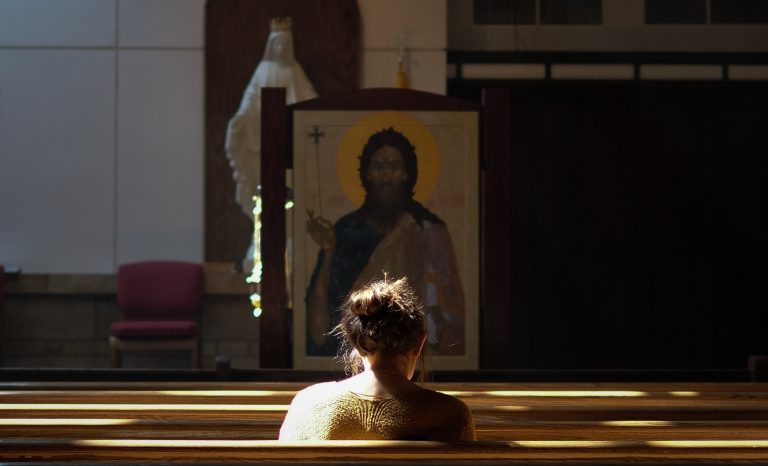By Louis St. Hilaire
Louis St. Hilaire is the author of That You Might Have Life: An Introduction to the Paschal Mystery of Christ and translator of The Literal Exposition of Isaiah: A Commentary by St. Thomas Aquinas (forthcoming from Emmaus Academic). A graduate of Franciscan University of Steubenville, he works as a web developer and digital editor for the St. Paul Center.

All prayer is a raising of the heart to God, but every believer responds to God’s invitation differently, so this raising of the heart can be expressed in many ways. Christian Tradition has particularly recognized three primary expressions of prayer: vocal prayer, meditation, and contemplation (CCC 2699).
Vocal Prayer
It can go without saying that prayer can be vocal. We know from our experience in and out of church that we pray out loud. But what does it mean to pray with our voices? From infancy we make noise with our vocal cords to communicate. We learn to speak in words and phrases to communicate our ever deeper and more complex needs, from hunger and tiredness to fear, anxiety, and love. We spend our lives engaged in conversation with others, and it’s so natural and authentically human to speak aloud. Consider this in the light of the prologue of the Gospel of John:
“In the beginning was the Word, and the Word was with God, and the Word was God. He was in the beginning with God; all things were made through him, and without him was not anything made that was made. In him was life, and the life was the light of men. The light shines in the darkness, and the darkness has not overcome it. (John 1:1–5)”
John calls Jesus “the Word” (in Greek, Logos). According to John, God speaks his Word, and through the Word, creation comes into being. That creation unfolds and brings the light of God into the world. This gets at a key element of speech communication: speech removes doubt and darkness. We speak in order to clarify the truth, and we speak to make ourselves known clearly.
Just as speech is necessary to human survival and thriving, vocal prayer is necessary to spiritual growth and holiness. While prayer is defined by the inner movement of the heart toward God, as bodily beings, with voices and ears, it’s fitting that the content of our hearts should be expressed outwardly in words. In this way, we pray with our whole being—body and spirit—and we also are able to pray with others. In doing so, we follow the example of Jesus, who prayed vocally in the synagogue with friends, family, and strangers, and in private by himself (CCC 2700–2704).
Mental Prayer
As vocal prayer is natural to humanity, so too is the natural progression to non-verbal means of communication. Have you had the experience of being with a close family member or friend and being able to communicate with him or her with a look or body language, or even knowing what he or she was going to say intuitively? We can and often do communicate silently because of our deep knowledge of those close to us. This gives us a glimpse into internal or mental prayer: meditation and contemplation.
Meditation
Meditation, properly speaking, is active mental prayer:
“Meditation engages thought, imagination, emotion, and desire. This mobilization of faculties is necessary in order to deepen our convictions of faith, prompt the conversion of our heart, and strengthen our will to follow Christ." (CCC 2708)
Meditation requires concentration and commitment that can be difficult to sustain, but there are many things that can help us. First among these are the Scriptures and other spiritual books. As previously mentioned, meditation is a central part of lectio divina. Engaging the drama of Scripture or a spiritual work with our minds, imagination, and emotions allows us to enter into the scene as a character. We get a chance to react to the situations and engage the other characters. In this way we get to learn about ourselves in evaluating our reactions, and we open ourselves up to God’s presence in his Word (CCC 2705).
In addition to the Scriptures and writings of spiritual authors, we can find inspiration for meditation in the actions and words of the liturgy, in icons and other sacred art, or in God’s work in creation, history, and our own lives. If we are humble and faithful, all these things can move our hearts to thoughtful reflection so that we can discover how God might be speaking to us through them and what he wants us to do in response (CCC 2706).
Contemplation
Meditation is of great value in actively engaging our thought, imagination, emotion, and desire, but our prayer can go further—from meditation on the mysteries of Christ to union with Christ himself and the experience of his love in contemplation.
St. Teresa of Ávila (1515–1582), a master of the life of prayer and a doctor of the Church, describes contemplative prayer as “a close sharing between friends; it means taking time frequently to be alone with him who we know loves us.” This prayer goes beyond words to let us simply be in God’s presence for a time. That’s it: contemplation is to make ourselves quiet, “gather up” our hearts, and sit in silence and spend time with God. It’s like when a married couple just sits together, holding hands, or when a baby rests silently in her mother’s arms. It’s a time of profound communion and rest.
This sounds simple, but it’s not always so easy. It requires making time for the Lord and a firm determination not to give up in seeking to know him. When thoughts, boredom, distractions, or emotions pull our mind in many directions, we need to allow God to pull our will back to silence and recollection. Then the Holy Spirit can continue pouring his love into our hearts.
Just like a human relationship where we only grow through the process of building trust and openness, contemplative prayer is only possible if we make ourselves vulnerable to God. In doing so, we allow God into our souls in a deeper, more profound way. This involves effort on our part, but ultimately, contemplation is a grace that God gives. This is an important point: all prayer involves both our own effort and God’s grace. We cooperate with God’s grace in willing acceptance of his invitation to spiritual growth, and this cooperation makes the experience of God’s love in contemplative prayer an attainable goal (CCC 2713).
You Might Also Like
Personal Prayer: A Guide for Receiving the Father’s Love brings the depth of human experience together with the Catholic tradition of prayer to present the path to an intimate and vulnerable relationship with God.


